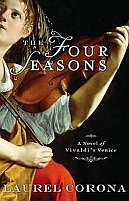|
|
BOOK
ILLUMINATIONS
From Merrimon Book Reviews
HOME
ROMANCE
FICTION SUSPENSE & THRILLERS
MYSTERY HORROR
AUTHORS REVIEWER
PROFILES
|
The Four Seasons:
A Novel of Vivaldi's Venice
 by Laurel Corona
by Laurel Corona

The voice of women from 18th
century Venice
In the thick fog of Venice, an unknown
woman abandons her two children, Chiaretta and Maddalena, on the steps
of a combined foundling home and celebrated musical school, the
Ospedale Della Pieta. From the very beginning, the difference of the
two sisters emerges even as they cling together. Chiaretta responds to
the the newness of her surroundings with curiosity and an energetic
enthusiasm for the beautiful voices she hears. Maddalena is a more
quiet introverted soul, responding to newness with anxiety. Although
she has initial difficulties advancing in her musical career, Vivaldi,
a composer hired by the Pieta, sees in her a gift that her superiors do
not. With his instruction to guide her, her passion for music grows
from within. As a violin virtuso and Vivaldi's muse, Maddalana must
balance her feelings for the man and her devotion to music. Unlike her
sister, Chiaretta craves open space. Despite her love for music, her
restless nature and a scandal lead her on a different path than her
sister as she marries into one of Venice's prestigious and aristocratic
families, facing new challenges from the petty but ever so damaging
gossip mongers to wielding power of her own.
Laurel Corona's THE FOUR SEASONS
presents a portrait of the lives of two different sisters. Through
their different personalities and choices, THE FOUR SEASONS makes 18th century
Venice, a place where few options were available for women other than
to marry or become nuns, come alive through the fictional lives of two
of the city's remarkable women. Nurtured and challenged by two
different men, a musician and an aristocrat, each woman makes a way for
herself within the closed structures available to her though small
choices and a passion for music.
Juxtaposed to her more intimate portraits of individual women, Laurel
Corona creates an intriguing and sometimes chilling portrait of a
society and its relationship to women. The city's celebrated musical
school creates a mystique about the virginal figlie de coro, daughters
of the choir, not allowing them to be seen as they perform behind a
grille while at the same time hiring them out to parties. The Ospedale
Della Pieta acts as both a benefactor for women with its musical school
while at the same time marketing them in ways that confine and regulate
them, removing individual choices. Through a look at the two separate
lives and careers of two foundling women, Laurel Corona makes present
to readers a city outside the Pieta, a city brimming with life and
vivacity yet a city where scandal, gossip and strict stratification can
damage a woman's honor and future possibilities. Through her portrait
of the Pieta, Laurel Corona shows the underside of a city beneath the
public face and social structures in the lives of abandoned women, and
yet at the same time, her narrative presents a compelling story of
women whose lives develop from within the hidden walls of the Pieta.
Laurel Corona's THE FOUR SEASONS
creates a powerful story of two women with a bond of sisterhood and yet
individuals in their own right, two women whose voices speak out beyond
and against the codified roles of women of the time.
Readers coming to Laurel Corona's THE
FOUR SEASONS from a desire to repeat the reading experience of
Barbara Quick's VIVALDI'S VIRGINS
should not expect to find the same book. Each book embodies a different
aspect of historical fiction, each wonderful in its own right. Readers
of Barbara Quick's VIVALDI'S VIRGINS
will take delight in revisiting the world of the Ospedale della Pieta
with a familiarity other readers may not have. Barbara Quick's VIVALDI'S VIRGINS character speaks
within her own voice, in a cry from the heart with a poetic language
that haunts me to this day. Laurel Corona's book THE FOUR SEASONS with its third
person narrative creates a narrative embodied with a sense of realism,
accompanied by moving thematic parallels and intersections, that makes
present two different kinds of women through their lives. In Barbara
Quick's novel, the reader hears the intimate voice of a daughter crying
out for her mother. In Laurel Corona's THE FOUR SEASONS, the reader feels
the voice of women from a slightly more distant narrative voice, a
voice distant and yet inclusive enough so that the reader sees the bond
of sisterhood, the sister's uniqueness and individuality, and women who
both live within a society with prescribed roles for women, women who
nevertheless, create their own sense of freedom and choice. Although
some readers might feel a preference for one kind of narrative voice
over the other, my recommendation would be to read both books, not
expecting one to be the same as the other. Together, the different
voices of both books clearly show the beauty of historical fiction and
its power to bring alive, through fiction, the voices of women in
history.
Publisher: Voice
(November 2008)
Reviewed by Merrimon,
Merrimon Book Reviews
Review Courtesy of Amazon Vine

|
|
|